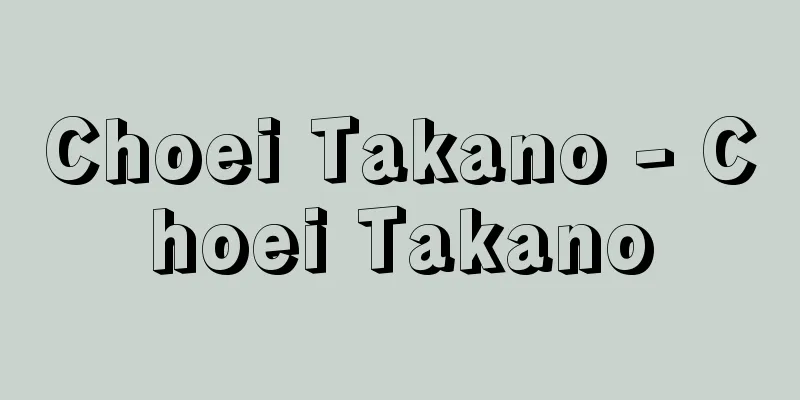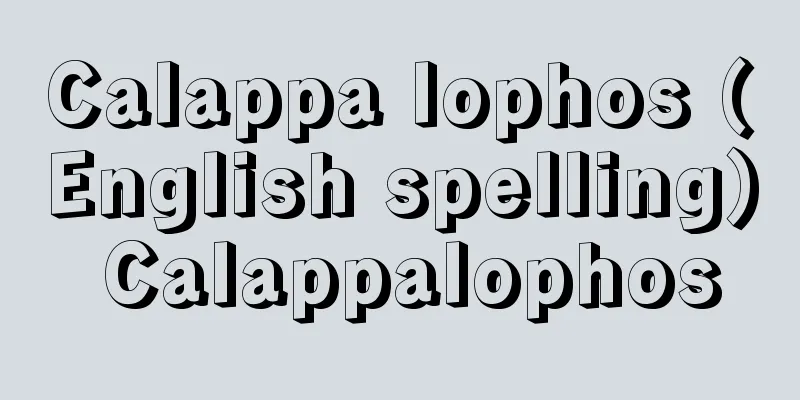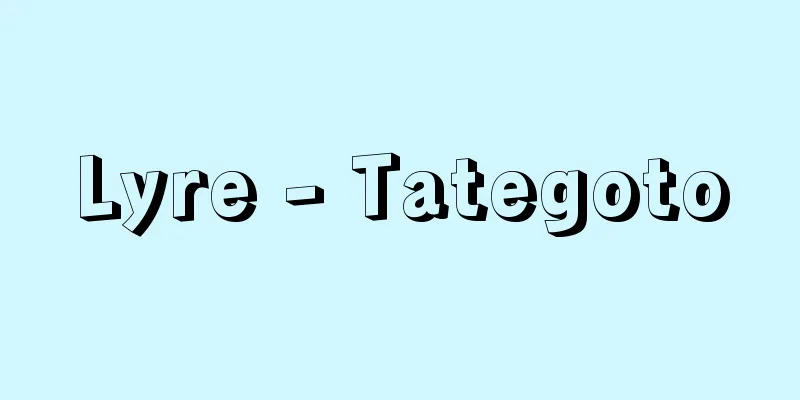Choei Takano - Choei Takano

|
A scholar of Dutch studies and thinker in the late Edo period. His given name was Yuzuru, his pen name was Zuikou, and he was commonly known as Keisai. He was born in 1812 in Mizusawa, Oshu (Oshu city, Iwate prefecture). He was the third son of Goto Sosuke Sanenobu (?-1812), a vassal of Date Shogen, a member of the clan of the Lord of Sendai. When he was nine years old, his father Sanenobu died, and he became the adopted heir of Takano Gensai (1771/1775-1827), his mother Miyo's older brother and court physician. Gensai was a pupil of Sugita Genpaku. At the age of 17, he accompanied his older brother Tansai (?-1823) to Edo to study, and became a pupil of Sugita Hakugen (Genpaku's adopted son). He eventually left Sugita School and became an apprentice under Yoshida Choshuku (1779-1824), where he studied Dutch medicine. In 1822 (Bunsei 5), at the age of 19, he changed his nickname to Choei and engaged in medicinal herbs in the Nikko and Tsukubayama areas, while also beginning to study Dutch grammar. In 1825, he went to Nagasaki and entered Siebold's Narutaki School. At the age of 23, he submitted a Dutch thesis to Siebold and was given the title of Doctor. With the support of Lord Matsuura, lord of Hirado Domain, he began translating the 20 volumes of Shikeikyutsude (a chemistry book), and was also asked by Siebold to translate Japanese into Dutch. Despite receiving news of his adoptive father's death, he refused to return home, citing illness as the reason. When the Siebold Incident occurred in 1828, he fled Nagasaki. After that, he lived in Hiroshima, Onomichi, Osaka, and then Kyoto, where he opened a practice. From there, he wrote a letter to a relative, renouncing his right to inherit the Takano family and vowing not to serve another family. This was because he wanted to continue his research in Western physiology. In 1830 (Tenpo 1), he returned to Edo and opened a practice in Kaizaka, Kojimachi, while continuing his research in physiology. In 1832, he completed the inner five volumes of Seisetsu Ihara Shuyo. As he was close to the residence of Watanabe Kazan at Hanzomon Tonodawara Domain, he translated Dutch books at Kazan's request, and deepened his friendship with Kazan, Egawa Hidetatsu, and others by participating in the Shoshi Society. In 1837, he went on a business trip to the Joshu and Joso regions, where he lectured on Western studies and provided medical treatment. In 1838, he wrote "Bojutsu Yume Monogatari" (A Tale of the Year of the Dog) in which he criticized the shogunate's policy of expelling foreign ships. That winter, he married his wife Yuki (his background is unknown). The following year, in 1839, the Shoshikai group was oppressed, and when Kazan was summoned to Bansha Prison for his criticism of the shogunate in his "Shinkiron" (A Treatise on the Cause of Sin) and "Shoyo Jijosho" (A Book on Western Affairs) (1839), he went into hiding for a time, but then turned himself in to the Kitamachi Bugyosho (Magistrate's Office). While in prison, he wrote "Wasuregatami" (1839) and protested his innocence, but was sentenced to life imprisonment for his criticism of the shogunate in "Bojutsu Yume Monogatari". In 1841, he became a prison headman and wrote "Bansha Soyaku Koki" (A Record of the Disasters of the Bansha) and sent it to his local party. The following year, in 1842, he attempted to be pardoned and released from prison, but to no avail. In 1844 (Koka 1), at the age of 40, he had the hinin Eizo set fire to the prison and escaped from the Kodenma-cho prison, hiding in Edo city under the protection of Suzuki Shunzan. During that time, he helped Shunzan translate military science books. That same year, his eldest son, Toru, was born. In 1847, he presented "Chikae Issuke" to Date Munenari, the lord of Uwajima domain, and completed the translation of "Sanpeito Kochiki." In 1848 (Kaei 1), he was invited by Date Munenari to go to Uwajima (Uwajima city, Ehime prefecture). He taught Dutch books under the name Ito Zuikei, and translated military books such as "Hoka Hisdoku." In the same year, he left Uwajima, passed through Hiroshima, and later re-entered Edo. Takahashi Ryusuke practiced medicine under the name of Sawa Sanpaku, but was attacked by police officers in October 1850 and committed suicide at the age of 47. As the leading disciple of Siebold, his ideas were based on the acquisition of modern Western academic methods and knowledge through Dutch linguistics and medicine. This led to his opposition to the traditional feudal teaching of Neo-Confucianism, which led to his suppression by conservatives such as Torii Yozo, the second son of Hayashi Shusai. However, the Western learning of Choei and others was eventually carried over to the intellectual revolution of the Enlightenment period, and played a major role in modernization. This point is also clear from the observations of Fujita Mokichi (1852-1892) in his History of the Eastward Expansion of Civilization (1884), and should be highly evaluated. [Akira Fujiwara June 20, 2016] "Takano Choei, annotated by Sato Shosuke (included in "Japanese Thought Series 55", 1971, Iwanami Shoten)" ▽ "The Complete Works of Takano Choei, 6 volumes (1978-1982, Daiichi Shobo)" ▽ "Takano Choei, by Sato Shosuke (Iwanami Shinsho)" [References] | | | | | |Sugita | |Date | | | | |Source: Shogakukan Encyclopedia Nipponica About Encyclopedia Nipponica Information | Legend |
|
江戸後期の蘭学(らんがく)者、思想家。名は譲、号は瑞皐(ずいこう)、通称卿斎(けいさい)。文化(ぶんか)元年奥州水沢(岩手県奥州(おうしゅう)市)に生まれる。仙台侯の一門伊達将監(だてしょうげん)の家臣後藤摠介実慶(そうすけさねのぶ)(?―1812)の三男。9歳のとき父実慶が死亡し、母美代の兄で侍医の高野玄斎(1771/1775―1827)の養嗣子(ようしし)となる。玄斎は杉田玄白の門人。17歳で兄堪斎(たんさい)(?―1823)に同行して江戸に遊学、杉田伯元(はくげん)(玄白の養子)の門に入る。やがて杉田塾を辞し、吉田長叔(よしだちょうしゅく)(1779―1824)の内弟子となり、オランダ医学を修めた。19歳の1822年(文政5)通称を長英と改め、日光、筑波(つくば)山地方において採薬に従事するとともに蘭文法の研究を始める。1825年長崎に赴き、シーボルトの鳴滝(なるたき)塾に入る。23歳で蘭語論文をシーボルトに提出し、ドクトルの称号を受けた。平戸(ひらど)藩主松浦(まつら)侯の援助で『シケイキュツデ』(化学書)20巻の翻訳に着手し、またシーボルトの依頼により和文蘭訳の業にも従った。養父の訃報(ふほう)に接するも病気を理由に帰郷を拒む。 1828年シーボルト事件が起こるや長崎から逃亡。以後広島、尾道(おのみち)、大坂を経て京都で開業した。同地より親戚(しんせき)にあて、高野家相続権を放棄し、また他家に禄仕(ろくし)しないことを誓う。これは西洋生理学研究を続けたいがためであった。1830年(天保1)江戸に戻り、麹町(こうじまち)貝坂で開業、かたわら生理学研究を進める。1832年『西説医原枢要』内編5巻を脱稿。渡辺崋山(わたなべかざん)の住む半蔵門外田原藩邸に近かった関係で崋山の依頼による蘭書の訳述を行い、崋山や江川英龍(えがわひでたつ)らと尚歯(しょうし)会に参加して交際を深めた。1837年上州、常総地方に出張し、洋学を講じ診療を行う。1838年『戊戌(ぼじゅつ)夢物語』を草し、幕府の異国船撃攘(げきじょう)策を批判する。この冬、妻ゆき(経歴未詳)と結婚。翌1839年尚歯会グループに加えられた弾圧事件、蛮社(ばんしゃ)の獄で崋山が『慎機(しんき)論』および『西洋事情書』(1839)による幕政批判の罪で召喚されるや、いったん姿を隠すも、北町奉行(ぶぎょう)所に自首する。獄中『わすれがたみ』(1839)を著し無実を訴えるが、『戊戌夢物語』による幕政批判の罪で永牢(えいろう)の判決を受ける。1841年牢名主(ろうなぬし)となり、『蛮社遭厄(そうやく)小記』を草し郷党に送る。翌1842年赦免出獄を画策するも効なく、1844年(弘化1)40歳にて非人栄蔵に放火させ、小伝馬(こでんま)町の牢舎から脱獄、鈴木春山の庇護(ひご)の下に江戸市中に潜伏。その間、春山の兵学書翻訳を助ける。この年、長男の融(とおる)が生まれた。1847年『知彼一助』を宇和島藩主伊達宗城(むねなり)に献上、『三兵答古知幾(タクチーキ)』を訳了。1848年(嘉永1)伊達宗城に招かれ宇和島(愛媛県宇和島市)に行く。伊藤瑞渓(いとうずいけい)の名で蘭書を教授し、『礮家(ほうか)必読』などの兵書を翻訳する。同年宇和島を去り、広島を経由し、のち江戸に再潜入。高橋柳助、沢三伯の名で医業を営むも、嘉永(かえい)3年10月捕吏に襲われ自刃。47歳。 彼の思想は、シーボルト門下の第一人者として、蘭語学、蘭医学を通し西洋近代学術の方法と知識を身につけていた点にある。そのため伝統的封建教学である朱子学に対決し、林述斎(じゅつさい)の次男鳥居耀蔵(とりいようぞう)ら守旧派による弾圧を招いた。しかし、やがて長英らの洋学は文明開化期の知的革命に受け継がれ、近代化に大きく作用した。この点は藤田茂吉(ふじたもきち)(1852―1892)『文明東漸史』(1884)の指摘にも明らかであり、高く評価されなければならない。 [藤原 暹 2016年6月20日] 『佐藤昌介校注『高野長英』(『日本思想大系55』所収・1971・岩波書店)』▽『『高野長英全集』全6巻(1978~1982・第一書房)』▽『佐藤昌介著『高野長英』(岩波新書)』 [参照項目] | | | | | | | | | | | | |出典 小学館 日本大百科全書(ニッポニカ)日本大百科全書(ニッポニカ)について 情報 | 凡例 |
Recommend
Big Man (English)
...Over 1,000 different languages are spoken ac...
Equatorial Guinea - Guinea Ecuatorial
A country in the central-west of Africa consistin...
Simeon ben Yoḥai (English spelling)
…The title of the book means “Book of Splendor.” ...
Japan External Trade Organization
…Japan External Trade Organization (JETRO) is a s...
Ichiburi (Niigata) - Ichiburi
...There is a cave near Mt. Gongen in the northwe...
Hamon (English spelling) excommunication
The original word excommunication (Latin: excommu...
Echidna (English spelling)
In Greek mythology, she is a monster with the upp...
Winnum - Winnum
…an alcoholic beverage made by fermenting grapes....
Matthias Jochumsson
1835‐1920 Icelandic poet and playwright. Born to a...
Yoshihiro Inayama
Manager. Born in Tokyo. Graduated from the Depart...
Katsurahama
This is a beach at the mouth of Urado Bay in Koch...
Atopic dermatitis
It is used in a similar sense to atopic disease, a...
HVJ virus - HVJ virus
...The most well-known are Langhans giant cells i...
NUWSS - NU Double S
In the same year, women gained the right to vote ...
Finsen, Niels Ryberg
Born: December 15, 1860, Torshavn Died: September ...









